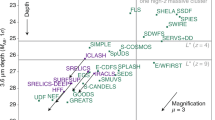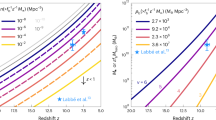Abstract
Replying to: P. Wolf et al. Nature doi:10.1038/nature09340 (2010)
We stand by our result1. The Comment2 revisits an interesting issue that has been known for decades3,4,5. Because it applies to all experiments, classical redshift tests6,7 and atom interferometry redshift tests are equivalent for all aspects in question. https://www.nature.com/articles/nature09340
Similar content being viewed by others
Main
We first note that no experiment is sensitive to the absolute value of a potential U. When two similar clocks at rest in the laboratory frame are compared in a classical redshift test, their frequency difference Δv/v = ΔU/c2 is given by  , where g = ∇ U is the gravitational acceleration in the laboratory frame, h is the clock’s separation, c is the velocity of light, and
, where g = ∇ U is the gravitational acceleration in the laboratory frame, h is the clock’s separation, c is the velocity of light, and  indicates terms of order h2 and higher. Therefore, classical redshift tests are sensitive to g, not to the absolute value of U, just like atom interferometry redshift tests. For classical redshift tests, as for any experiment, all effects of conventional gravity, including the redshift, are eliminated locally inside a freely falling laboratory8. If the clock’s trajectory is tracked from a fixed ground station, the complete experiment is not in free fall. Also, the redshift is ΔU/c2, independent of whether the clocks are compared by exchange of electromagnetic signals or clock transport8.
indicates terms of order h2 and higher. Therefore, classical redshift tests are sensitive to g, not to the absolute value of U, just like atom interferometry redshift tests. For classical redshift tests, as for any experiment, all effects of conventional gravity, including the redshift, are eliminated locally inside a freely falling laboratory8. If the clock’s trajectory is tracked from a fixed ground station, the complete experiment is not in free fall. Also, the redshift is ΔU/c2, independent of whether the clocks are compared by exchange of electromagnetic signals or clock transport8.
The atom interferometry signal ϕ = ϕr + ϕt + ϕi is the sum of contributions of the redshift ϕr = kg T2 = (mc2/ )
) to the Compton frequency ωC = mc2/
to the Compton frequency ωC = mc2/ (where k is the wavevector, T the pulse separation time1, m the rest mass of the atom, and
(where k is the wavevector, T the pulse separation time1, m the rest mass of the atom, and  the reduced Planck constant), time dilation ϕt, and the laser–atom interaction ϕi. As is common in classical redshift tests, the time dilation ϕt due to the clocks’ motion is compensated for, so that a measurement of ϕr is obtained. This happens automatically, because ϕt + ϕi = 0. By interfering the atomic matter waves from the two paths, we obtain ϕ, which contains their proper time difference9. To compare to Einstein’s prediction, we measure g by tracking a falling corner cube’s position (apart from its proper time) by interfering light reflected off the corner cube.
the reduced Planck constant), time dilation ϕt, and the laser–atom interaction ϕi. As is common in classical redshift tests, the time dilation ϕt due to the clocks’ motion is compensated for, so that a measurement of ϕr is obtained. This happens automatically, because ϕt + ϕi = 0. By interfering the atomic matter waves from the two paths, we obtain ϕ, which contains their proper time difference9. To compare to Einstein’s prediction, we measure g by tracking a falling corner cube’s position (apart from its proper time) by interfering light reflected off the corner cube.
As has been pointed out4,8,10, the Einstein equivalence principle does not follow from tests of the universality of free fall (UFF) without redshift measurements. The Comment2, however, argues that we must use the Lagrangian equation (8) to derive the paths as well as the phases. It thus uses a case where measuring the redshift and testing UFF are equivalent and so the Einstein equivalence principle does follow from tests of UFF alone1. In this case, the Comment is correct that Δϕfree = ϕr + ϕt = 0, and thus atom interferometers measure the acceleration of free fall. Simultaneously, we are correct that ϕt + ϕi = 0, showing that they measure the redshift. Using this approach, however, precludes redshift anomalies without corresponding UFF violation. Any anomaly would cancel upon comparing measured and predicted redshifts, because the anomaly would also be contained in g. This has been shown explicitly for classical redshift tests5, and atom interferometers are no different in this respect.
The more general—and more interesting—scenario is that redshift and UFF violations can exist independently; explicit theoretical models for this have been proposed using, for example, non-minimal coupling11,12 or gravitoscalar and gravitovector fields13. Then Δϕfree = ϕr + ϕt is no longer zero, but our ϕt + ϕi = 0 still holds1, even for arbitrary simultaneous violations of UFF. Given that a complete theory exhibiting redshift anomalies while preserving UFF is not yet known, it would be premature to use a detailed model for such physics. Our analysis consequently allows (but does not require) the free-fall acceleration of the atoms g′ and the redshift to be independent. Similar assumptions have been applied to all previous5 and planned6 redshift experiments.
Atom interferometry redshift tests and classical redshift tests are both valid measurements of the gravitational redshift. Both remain important, because they test the Einstein equivalence principle over complementary parameters like elevation (1,000 km versus 1 mm), clock frequencies (109 Hz versus 1025 Hz), clock mechanisms (mostly hyperfine interactions versus mostly strong interactions), and methods (radio link versus clock transport). Considering the wide range of scenarios for physics beyond the standard model, it is important to probe the redshift on all experimentally accessible scales.
References
Müller, H., Peters, A. & Chu, S. A precision measurement of the gravitational redshift by the interference of matter waves. Nature 463, 926–929 (2010)
Wolf, P. et al. Atom gravimeters and gravitational redshift. Nature 10.1038/nature09340 (2010)
Schiff, L. On experimental tests of the general theory of relativity. Am. J. Phys. 28, 340–343 (1960)
Dicke, R. H. Eötvös experiment and the gravitational red shift. Am. J. Phys. 28, 344–347 (1960)
Nordtvedt, K. Quantitative relationship between clock gravitational “red-shift” violations and nonuniversality of free-fall rates in nonmetric theories of gravity. Phys. Rev. D 11, 245–247 (1975)
Vessot, R. F. C. et al. Test of relativistic gravitation with a space-borne hydrogen maser. Phys. Rev. Lett. 45, 2081–2084 (1980)
Cacciapuoti, L. & Salomon, C. Space clocks and fundamental tests: the ACES experiment. Eur. Phys. J. Spec. Top. 127, 57–68 (2009)
Will, C. M. Theory and Experiment in Gravitational Physics Ch. 2 (Cambridge University Press, 1993)
Bordé, C. J. 5D optics for atomic clocks and gravito-inertial sensors. Eur. Phys. J. Spec. Top. 163, 315–332 (2008)
Will, C. M. The confrontation between general relativity and experiment. Living Rev. Relativity 9 3 (2006) 〈http://relativity.livingreviews.org/Articles/lrr-2006-3/〉.
Coley, A. Schiff’s conjecture on gravitation. Phys. Rev. Lett. 49, 853–855 (1982)
Ni, W.-T. Equivalence principles and electromagnetism. Phys. Rev. Lett. 38, 301–304 (1977)
Nieto, M. M. & Goldmann, T. The arguments against “antigravity” and the gravitational acceleration of antimatter. Phys. Rep. 205, 221–281 (1991)
Author information
Authors and Affiliations
Contributions
All authors have contributed substantially to this work.
Ethics declarations
Competing interests
declared none.
Rights and permissions
About this article
Cite this article
Müller, H., Peters, A. & Chu, S. Müller, Peters & Chu reply . Nature 467, E2 (2010). https://doi.org/10.1038/nature09341
Issue Date:
DOI: https://doi.org/10.1038/nature09341
This article is cited by
-
Gravitational redshift and the vacuum index of refraction
Astrophysics and Space Science (2019)
-
Summary of session C9: experimental gravitation
General Relativity and Gravitation (2014)
Comments
By submitting a comment you agree to abide by our Terms and Community Guidelines. If you find something abusive or that does not comply with our terms or guidelines please flag it as inappropriate.



